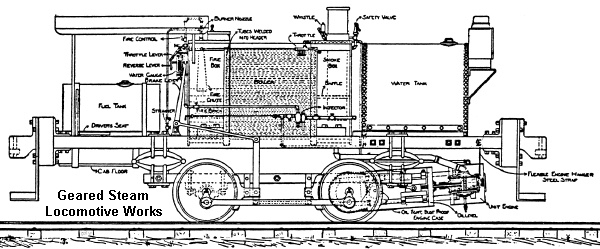Note the oil tank in front
of the boiler,
which replaces the cumbersome coal-tender.
With coal scarce and gasoline high-priced and much in demand for
all of our war activities, the oil-fired steam locomotive, burning
heavy grades of distillate or crude oil, is now winning favor in
plants where switching engines haul goods over short distances. The
oil-fired locomotive has many uses. It is found hauling logs in
camps far away from coal supplies or wending its way on sugar
plantations; or busily transporting from excavations for New York's
new subway system muck, rails, ties and ballast. Contractors select
the oil-fired locomotive because it does not pollute the atmosphere
with smoke. ****
DO NOT COPY **** Violators will be prosecuted! gearedsteam.com
In appearance, the fuel-fired locomotive, as shown in the
accompanying illustrations, does not differ much from the familiar
coal-fed type, except that a separate tank out in front of the
boiler takes the place of the usual coal-tender. The cost of
operation is said to be less than one cent a ton per mile. The
construction is clearly shown in the accompanying cross-sectional
view. **** DO
NOT COPY **** Violators will be prosecuted! gearedsteam.com

The new industrial
oil-fired steam locomotive in cross-sectional view.
Each part is plainly illustrated, showing the compact construction
of this coal-saving iron horse.
________________________________________________